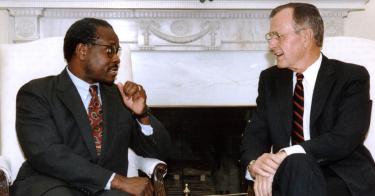Today is the anniversary of perhaps the most consequential decision made by President George H.W. Bush. On July 1, 1991, he nominated Clarence Thomas to the U.S. Supreme Court.
Thomas was nominated to replace Justice Thurgood Marshall, whom Professor Stephen Carter called an “old soldier of liberalism.” Thomas and Marshall represented two radically different approaches to judging and, as they often do, the conflict over Thomas’s nomination was really a conflict over judicial power. It was a conflict over whether to retain or reject America’s founders’ design for the judiciary.
Thomas was nominated because he embraced that design. Even before his tenure on the U.S. Court of Appeals for the D.C. Circuit, Thomas wrote that treating provisions in our written Constitution as sources of unwritten rights that only judges can discern turns the Constitution into “a blank check.”
Legal analyst Gordon Crovitz wrote at the time that Thomas “views his job as interpreting the law and not making it up or ruling for or against parties based on who they are.”
Thomas has followed the same principles on the Supreme Court. In a 1996 speech at the University of Kansas law school, he offered some reflections on “the process and theory of judging.” The duty of the federal courts, he said, “is to interpret and enforce . . . the Constitution and the body of federal statutory law” and to do so impartially. That duty requires “reducing judicial discretion” by, for example, interpreting the Constitution by seeking “the original understanding of the provision’s text . . . We as a nation adopted a written Constitution precisely because it has a fixed meaning that does not change.”
Fast forward to Thomas’s concurring opinion last month in Gamble v. United States, in which he also reflected on “our judicial duty” and, in particular, on the role that the Supreme Court’s precedents should play in its decision-making. As he had nearly a quarter century earlier, Thomas described the temptation for judges to decide cases based on their personal preferences rather than the law. Since federal judges “interpret and apply” written law such the Constitution, statutes, and regulations, they can resist this temptation best by “adherence to the correct, original meaning of the laws we are charged with applying.”
The real Constitution, the one that is the “supreme law of the land,” includes “the original meaning of the relevant legal text.” To be sure, that constitution presents a problem for certain political interests trying to achieve certain political objectives. At that point, something has to give. Thomas’ approach to judging says that the Constitution must win over politics every time.
For nearly three decades, Justice Clarence Thomas has shown how the judiciary can support or undermine our liberty by following rather than trying to control the law. America’s founders designed the judiciary, and President Bush nominated Thomas, to be on the right side of that conflict.
This piece originally appeared in the National Review on 7/1/19




